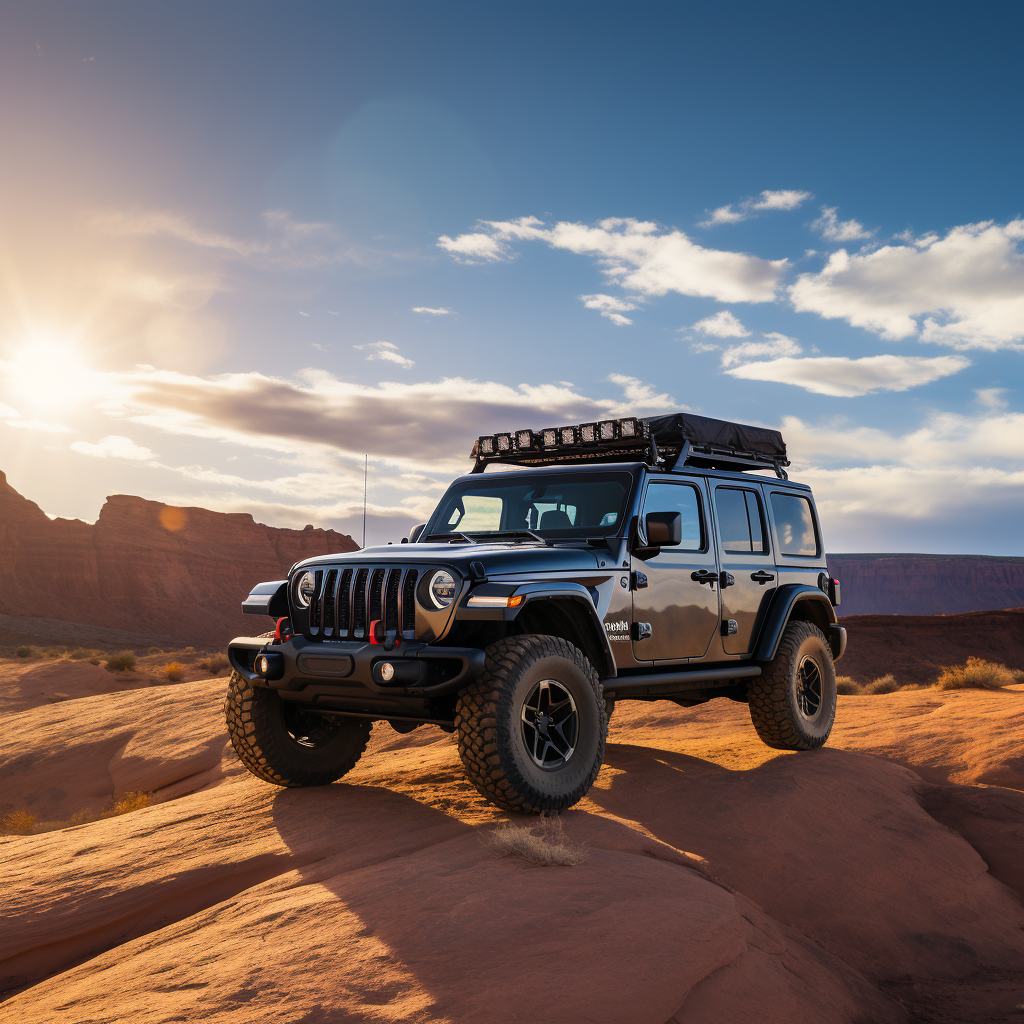If you own a Jeep Wrangler, you probably love it for its ruggedness, versatility, and off-road capabilities. But driving a Wrangler can also be challenging, especially if you are new to this type of vehicle. Wranglers are not known for their comfort, smoothness, or fuel efficiency. They have some quirks and features that require some skill and knowledge to handle properly.
In this article, we will share with you some of the best tips and tricks for driving your Jeep Wrangler, whether you are on the road or off the road. We will cover topics such as how to use the four-wheel drive system, how to improve your ride quality, how to deal with common problems and issues, and how to make the most of your Wrangler's unique features.
How to Use the Four-Wheel Drive System

One of the main attractions of the Jeep Wrangler is its four-wheel drive system, which allows you to tackle various terrains and conditions. However, using the four-wheel drive system correctly is not as simple as flipping a switch. You need to understand the different modes and when to use them.
The Wrangler has three different four-wheel drive modes: 2H (two-wheel drive high range), 4H (four-wheel drive high range), and 4L (four-wheel drive low range). Each mode has its own advantages and disadvantages, depending on the situation.
2H: This is the default mode for normal driving on paved roads. It only engages the rear wheels and provides better fuel economy and handling. You should use this mode when the road is dry and clear, and when you are driving at higher speeds (up to 55 mph).
4H: This mode engages all four wheels and provides more traction and stability. You should use this mode when the road is slippery or uneven, such as in snow, ice, mud, sand, or gravel. You can also use this mode for light off-roading on trails or hills. You can switch to this mode while driving up to 45 mph, but you should not exceed this speed limit when in 4H.
4L: This mode also engages all four wheels, but it reduces the gear ratio and increases the torque. This means that you have more power and control, but less speed. You should use this mode for serious off-roading on steep slopes, rocks, or obstacles. You can only switch to this mode when the vehicle is stopped or moving very slowly (less than 3 mph), and you should not exceed 25 mph when in 4L.
To switch between the different modes, you need to use the transfer case lever, which is located next to the transmission shifter. The lever has four positions: 2H, 4H, N (neutral), and 4L. To move from 2H to 4H or vice versa, you simply need to pull or push the lever while driving. To move from 4H to 4L or vice versa, you need to first put the transmission in neutral, then pull or push the lever firmly until it clicks into place.
Some tips for using the four-wheel drive system are:
Do not use 4H or 4L on dry pavement, as this can cause damage to the drivetrain and tires.
Do not switch between modes while turning or accelerating, as this can cause binding or slipping.
Do not drive faster than the recommended speed limits for each mode, as this can cause overheating or loss of control.
Do not forget to switch back to 2H when you are done with off-roading or driving on slippery roads.
Do check your owner's manual for more specific instructions and warnings.
How to Improve Your Ride Quality
Another common complaint about the Jeep Wrangler is its ride quality. Wranglers are not designed for comfort or smoothness; they are designed for durability and performance. They have a solid axle suspension system, which means that they have a rigid connection between the wheels on each side of the vehicle. This makes them more stable and capable off-road, but also more bumpy and noisy on-road.
Fortunately, there are some ways to improve your ride quality without compromising your Wrangler's capabilities. Some of them are:
Adjust your tire pressure: The tire pressure can affect how your Wrangler handles and rides on different surfaces. Too much pressure can make your ride harsher and louder; too little pressure can make your ride softer but less responsive. The recommended tire pressure for your Wrangler depends on several factors, such as the tire size, load weight, terrain type, and weather conditions. You can find the recommended tire pressure for your specific model on a sticker inside the driver's door jamb or in your owner's manual. You should check your tire pressure regularly and adjust it accordingly.
Change your shocks: The shocks are the parts of the suspension system that absorb the impact and vibration from the road. They can wear out over time and affect your ride quality. If your shocks are old, leaking, or damaged, you should replace them with new ones. You can also upgrade your shocks to aftermarket ones that offer better performance and comfort. There are different types of shocks available, such as gas, hydraulic, or air shocks. You should choose the ones that suit your driving style and preferences.
Change your tires: The tires are another important factor that influences your ride quality. They can also wear out over time and lose their grip and traction. If your tires are bald, cracked, or unevenly worn, you should replace them with new ones. You can also upgrade your tires to aftermarket ones that offer better performance and comfort. There are different types of tires available, such as all-season, all-terrain, or mud-terrain tires. You should choose the ones that match your driving conditions and needs.
Change your seats: The seats are where you spend most of your time in your Wrangler. They can also affect your ride quality by providing support and comfort. If your seats are old, torn, or uncomfortable, you should replace them with new ones. You can also upgrade your seats to aftermarket ones that offer better performance and comfort. There are different types of seats available, such as bucket, bench, or reclining seats. You should choose the ones that fit your body type and preferences.
How to Deal with Common Problems and Issues
Like any other vehicle, the Jeep Wrangler can have some problems and issues that require attention and maintenance. Some of the most common problems and issues that Wrangler owners face are:
Leaks: Wranglers are notorious for having leaks, especially in the soft top models. The leaks can come from various sources, such as the doors, windows, roof, or seals. The leaks can cause water damage, mold growth, or electrical problems. To prevent or fix leaks, you should check your Wrangler regularly for signs of moisture or stains. You should also clean and lubricate the seals and hinges regularly. You can also use waterproof covers or sprays to protect your Wrangler from rain or snow.
Rust: Wranglers are also prone to rusting, especially in the older models. The rust can affect the appearance and performance of your Wrangler. It can also cause safety issues if it affects the frame or other critical parts. To prevent or fix rust, you should wash and wax your Wrangler regularly to remove dirt and salt. You should also inspect your Wrangler regularly for signs of rust or corrosion. You can also use anti-rust products or coatings to protect your Wrangler from rusting.
Death wobble: Death wobble is a term used to describe a violent shaking of the front end of your Wrangler when driving at high speeds. It can be caused by various factors, such as worn or loose steering or suspension components, unbalanced or misaligned tires, or damaged drivetrain parts. Death wobble can be very scary and dangerous if not addressed properly. To prevent or fix death wobble, you should check and tighten all the bolts and nuts in your steering and suspension system regularly. You should also balance and align your tires regularly. You should also replace any damaged or worn parts as soon as possible.
How to Make the Most of Your Wrangler's Unique Features
One of the best things about owning a Jeep Wrangler is its unique features that make it stand out from other vehicles. Some of these features are:
Removable doors: Wranglers are one of the few vehicles that allow you to remove the doors for a more open-air experience. Removing the doors is not very difficult; you just need to disconnect the wiring harnesses, remove the nuts and bolts, and lift the doors off their hinges. However, you should be aware of some things before removing the doors, such as:
You should check your local laws and regulations regarding driving without doors, as some states may require you to have mirrors or other safety equipment.
You should store your doors in a safe and dry place when not in use, as they can be heavy and expensive to replace.
You should drive carefully and cautiously without doors, as you may have less visibility and protection.
You should check your local laws and regulations regarding driving without doors, as some states may require you to have mirrors or other safety equipment.
Foldable windshield: Wranglers are also one of the few vehicles that allow you to fold down the windshield for a more open-air experience. Folding down the windshield is not very difficult; you just need to remove the wipers, disconnect the wiring harnesses, remove the bolts and clips, and fold down the windshield onto the hood. However, you should be aware of some things before folding down the windshield, such as:
You should check your local laws and regulations regarding driving with a folded windshield, as some states may require you to have eye protection or other safety equipment.
You should protect your dashboard and instruments from dust and debris when driving with a folded windshield, as they can be
These are some of the best tips and tricks for driving your Jeep Wrangler. By following these tips, you can enjoy your Wrangler to the fullest and make it last longer. Remember, your Wrangler is not just a vehicle; it is a lifestyle. Happy driving!


